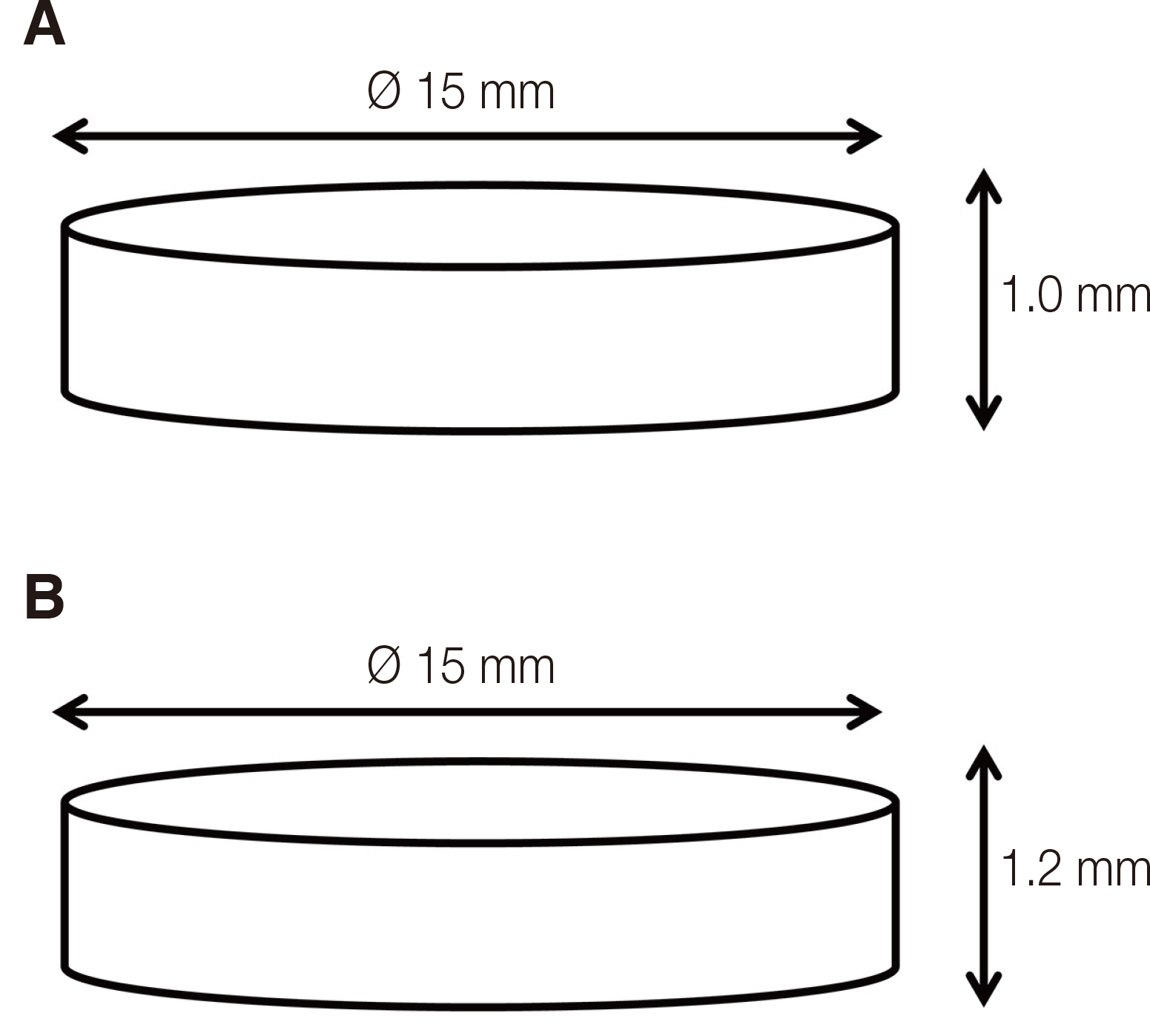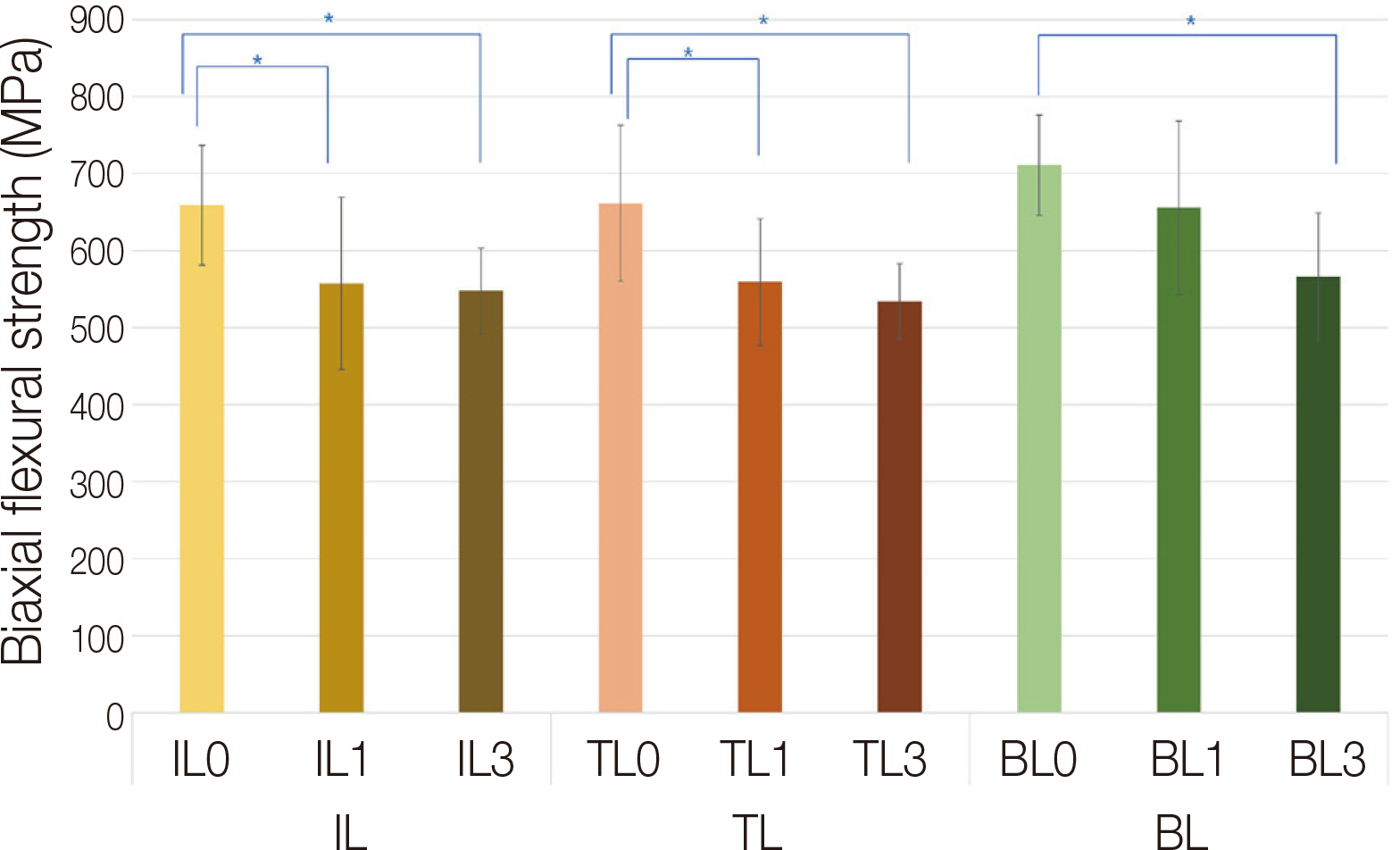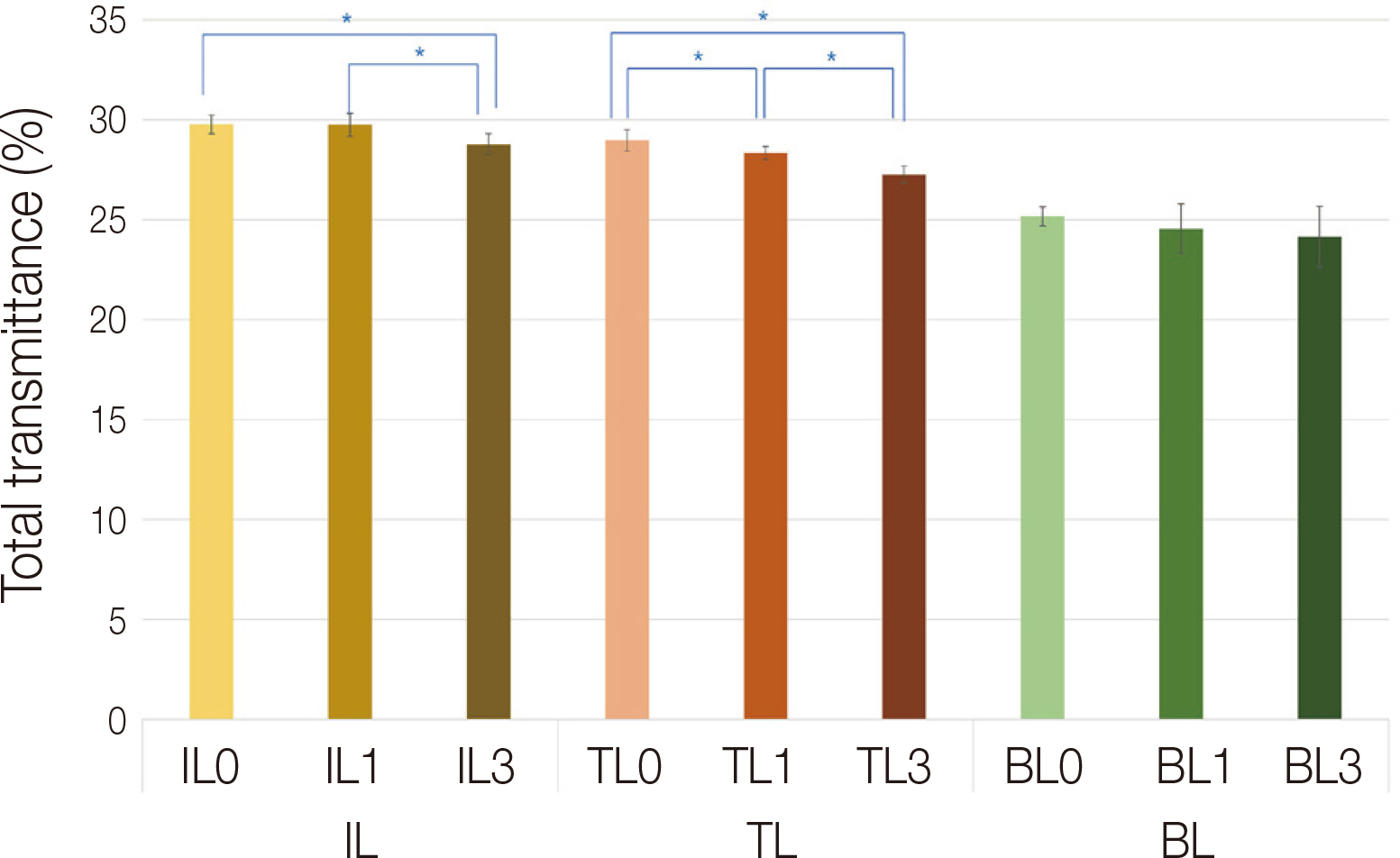J Dent Rehabil Appl Sci.
2021 Sep;37(3):111-122. 10.14368/jdras.2021.37.3.111.
The comparisons of layers and the effect of additional firings on flexural strength and translucency of 5Y-ZP
- Affiliations
-
- 1Department of Prosthodontics, College of Dentistry, Dankook University, Cheonan, Republic of Korea
- KMID: 2525985
- DOI: http://doi.org/10.14368/jdras.2021.37.3.111
Abstract
- Purpose
The purpose of this in vitro study was to investigate the flexural strength and translucency of three layers in 5Y-ZP and to assess the effect of additional firings on these properties.
Materials and Methods
Sintered zirconia blocks were sectioned according to three layers : incisal, transition, and body. Disc-shaped specimens were fabricated from each layer. The diameter of specimens was 15.0 mm and each thickness of specimens for biaxial flexural strength test and translucency was 1.2 mm and 1.0 mm. The specimens were classified into subgroups according to the number of firing (0, 1, and 3 times; n = 10/subgroup) and the additional firings were performed under 900°C using a furnace. Biaxial flexural strength and translucency was measured using universal testing machine and uv-vis spectrophotometer. X-ray diffraction (XRD) analysis was used for measurement of the phase identification. Oneway ANOVA, Tukey HSD test were performed (α = 0.05).
Results
There was no significant difference in flexural strength between the three layers (P > 0.05), while there was significant difference in translucency between different layers (P < 0.05). The flexural strength of incisal and transition layer was decreased by the single additional firing, and the three additional firings significantly decreased the flexural strength of three layers. The translucency of layer was decreased by additional firings except the body layer. The XRD patterns of all groups were similar.
Conclusion
Three layers of 5Y-ZP were different only in translucency. Additional firings affected the flexural strength and translucency differently depending on the layers but crystalline phases were not changed.
Keyword
Figure
Reference
-
References
1. Bagby M, Marshall SJ, Marshall GW Jr. 1990; Metal ceramic compatibility: a review of the literature. J Prosthet Dent. 63:21–5. DOI: 10.1016/0022-3913(90)90259-F. PMID: 2404102.2. Isgrò G, Pallav P, van der Zel JM, Feilzer AJ. 2003; The influence of the veneering porcelain and different surface treatments on the biaxial flexural strength of a heat-pressed ceramic. J Prosthet Dent. 90:465–73. DOI: 10.1016/j.prosdent.2003.08.003. PMID: 14586311.3. Kim HK, Kim SH, Lee JB, Han JS, Yeo IS, Ha SR. 2016; Effect of the amount of thickness reduction on color and translucency of dental monolithic zirconia ceramics. J Adv Prosthodont. 8:37–42. DOI: 10.4047/jap.2016.8.1.37. PMID: 26949486. PMCID: PMC4769888.4. Christel P, Meunier A, Heller M, Torre JP, Peille CN. 1989; Mechanical properties and short-term in-vivo evaluation of yttrium-oxide-partially-stabilized zirconia. J Biomed Mater Res. 23:45–61. DOI: 10.1002/jbm.820230105. PMID: 2708404.5. Teichmann M, Wienert AL, Rückbeil M, Weber V, Wolfart S, Edelhoff D. 2018; Ten-year survival and chipping rates and clinical quality grading of zirconia-based fixed dental prostheses. Clin Oral Investig. 22:2905–15. DOI: 10.1007/s00784-018-2378-1. PMID: 29520468.6. Stefanescu C, Ionita C, Nechita V, Drafta S, Oancea L, Petre A. 2018; Survival Rates and Complications for Zirconia-Based Fixed Dental Prostheses in a Period up to 10 Years: A Systematic Review. Eur J Prosthodont Restor Dent. 26:54–61. DOI: 10.1922/EJPRD_01681Stefanescu08. PMID: 29517875.7. Christensen GJ. 2011; The all-ceramic restoration dilemma: where are we? J Am Dent Assoc. 142:668–71. DOI: 10.14219/jada.archive.2011.0251. PMID: 21628690.8. Marchack BW, Sato S, Marchack CB, White SN. 2011; Complete and partial contour zirconia designs for crowns and fixed dental prostheses: a clinical report. J Prosthet Dent. 106:145–52. DOI: 10.1016/S0022-3913(11)60112-1. PMID: 21889000.9. Thalji GN, Cooper LF. 2014; Implant-supported fixed dental rehabilitation with monolithic zirconia: a clinical case report. J Esthet Restor Dent. 26:88–96. DOI: 10.1111/jerd.12078. PMID: 24382100.10. Malkondu O, Tinastepe N, Kazazoglu E. 2016; Influence of type of cement on the color and translucency of monolithic zirconia. J Prosthet Dent. 116:902–8. DOI: 10.1016/j.prosdent.2016.05.001. PMID: 27422235.11. da Silva LH, de Lima E, de Paula Miranda RB, Favero SS, Lohbauer U, Cesar PF. 2017; Dental ceramics: a review of new materials and processing methods. Braz Oral Res. 31 Suppl 1:e58. DOI: 10.1590/1807-3107bor-2017.vol31.0058. PMID: 28902238.12. da Silva LH, de Lima E, Hochman M, Özcan M, Cesar PF. 2017; Monolithic Zirconia for Prosthetic Reconstructions : Advantages and Limitations. Curr Oral Health Rep. 4:197–200. DOI: 10.1007/s40496-017-0153-z.13. Zhang F, Inokoshi M, Batuk M, Hadermann J, Naert I, Van Meerbeek B, Vleugels J. 2016; Strength, toughness and aging stability of highly-translucent Y-TZP ceramics for dental restorations. Dent Mater. 32:e327–37. DOI: 10.1016/j.dental.2016.09.025. PMID: 27697332.14. Kwon SJ, Lawson NC, McLaren EE, Nejat AH, Burgess JO. 2018; Comparison of the mechanical properties of translucent zirconia and lithium disilicate. J Prosthet Dent. 120:132–7. DOI: 10.1016/j.prosdent.2017.08.004. PMID: 29310875.15. Zhang Y, Lawn BR. 2018; Novel Zirconia Materials in Dentistry. J Dent Res. 97:140–7. DOI: 10.1177/0022034517737483. PMID: 29035694. PMCID: PMC5784474.16. Ueda K, Güth JF, Erdelt K, Stimmelmayr M, Kappert H, Beuer F. 2015; Light transmittance by a multi-coloured zirconia material. Dent Mater J. 34:310–4. DOI: 10.4012/dmj.2014-238. PMID: 25904173.17. Baldissara P, Llukacej A, Ciocca L, Valandro FL, Scotti R. 2010; Translucency of zirconia copings made with different CAD/CAM systems. J Prosthet Dent. 104:6–12. DOI: 10.1016/S0022-3913(10)60086-8. PMID: 20620365.18. Sato H, Yamada K, Pezzotti G, Nawa M, Ban S. 2008; Mechanical properties of dental zirconia ceramics changed with sandblasting and heat treatment. Dent Mater J. 27:408–14. DOI: 10.4012/dmj.27.408. PMID: 18717169.19. Zhang Y. 2014; Making yttria-stabilized tetragonal zirconia translucent. Dent Mater. 30:1195–203. DOI: 10.1016/j.dental.2014.08.375. PMID: 25193781. PMCID: PMC4167579.20. Nakamura K, Harada A, Ono M, Shibasaki H, Kanno T, Niwano Y, Adolfsson E, Milleding P, Örtengren U. 2016; Effect of low-temperature degradation on the mechanical and microstructural properties of tooth-colored 3Y-TZP ceramics. J Mech Behav Biomed Mater. 53:301–11. DOI: 10.1016/j.jmbbm.2015.08.031. PMID: 26382971.21. Shamseddine L, Majzoub Z. 2017; Relative Translucency of a Multilayered Ultratranslucent Zirconia Material. J Contemp Dent Pract. 18:1099–106. DOI: 10.5005/jp-journals-10024-2183. PMID: 29208782.22. Kolakarnprasert N, Kaizer MR, Kim DK, Zhang Y. 2019; New multi-layered zirconias: Composition, microstructure and translucency. Dent Mater. 35:797–806. DOI: 10.1016/j.dental.2019.02.017. PMID: 30853208. PMCID: PMC6462415.23. International Organization for Standardization. ISO 6872:2015 Dentistry - ceramic materials. Available from: https://www.iso.org/standard/59936.html. updated 2021 Sep 6.24. ASTM International. ASTM F394-78 (1996), Test Method for Biaxial Flexure Strength (Modulus of Rupture) of Ceramic Substrates (Withdrawn 2001). PA;West Conshohocken:25. International commission on illumination. CIE S 017-2011. International lighting vocabulary. CIE;Vienna, Austria: Available from: http://cie.co.at. updated 2015 Nov 16.26. Japanese Standards Association. JIS Z 8113-1998. Lighting vocabulary. Japanese Standards Association;Tokyo, Japan: Available from: http://www.jsa.or.jp. updated 2015 Nov 16.27. Seo DG, Roh BD. 2006; The comparison of relative reliability on biaxial and three point flexural strength testing methods of light curing composite resin. J Korean Acad Cons Dent. 31:58–65. DOI: 10.5395/JKACD.2006.31.1.058.28. Anusavice KJ, Kakar K, Ferree N. 2007; Which mechanical and physical testing methods are relevant for predicting the clinical performance of ceramic-based dental prostheses? Clin Oral Implants Res. 18:218–31. DOI: 10.1111/j.1600-0501.2007.01460.x. PMID: 17594384.29. Wille S, Zumstrull P, Kaidas V, Jessen LK, Kern M. 2018; Low temperature degradation of single layers of multilayered zirconia in comparison to conventional unshaded zirconia: Phase transformation and flexural strength. J Mech Behav Biomed Mater. 77:171–5. DOI: 10.1016/j.jmbbm.2017.09.010. PMID: 28918009.30. Xie H, Gu Y, Li Q, Qian M, Zhang F, Tay FR, Chen C. 2016; Effects of multiple firings on the low-temperature degradation of dental yttria-stabilized tetragonal zirconia. J Prosthet Dent. 115:495–500. DOI: 10.1016/j.prosdent.2015.08.029. PMID: 26723091.31. Nakamura K, Adolfsson E, Milleding P, Kanno T, Örtengren U. 2012; Influence of grain size and veneer firing process on the flexural strength of zirconia ceramics. Eur J Oral Sci. 120:249–54. DOI: 10.1111/j.1600-0722.2012.00958.x. PMID: 22607342.32. Chevalier J. 2006; What future for zirconia as a biomaterial? Biomaterials. 27:535–43. DOI: 10.1016/j.biomaterials.2005.07.034. PMID: 16143387.33. Brodbelt RH, O'Brien WJ, Fan PL. 1980; Translucency of dental porcelains. J Dent Res. 59:70–5. DOI: 10.1177/00220345800590011101. PMID: 6927988.34. Johnston WM, Reisbick MH. 1997; Color and translucency changes during and after curing of esthetic restorative materials. Dent Mater. 13:89–97. DOI: 10.1016/S0109-5641(97)80017-6. PMID: 9467310.35. Wang F, Takahashi H, Iwasaki N. 2013; Translucency of dental ceramics with different thicknesses. J Prosthet Dent. 110:14–20. DOI: 10.1016/S0022-3913(13)60333-9. PMID: 23849609.36. Awad D, Stawarczyk B, Liebermann A, Ilie N. 2015; Translucency of esthetic dental restorative CAD/CAM materials and composite resins with respect to thickness and surface roughness. J Prosthet Dent. 113:534–40. DOI: 10.1016/j.prosdent.2014.12.003. PMID: 25749093.37. Harada K, Raigrodski AJ, Chung KH, Flinn BD, Dogan S, Mancl LA. 2016; A comparative evaluation of the translucency of zirconias and lithium disilicate for monolithic restorations. J Prosthet Dent. 116:257–63. DOI: 10.1016/j.prosdent.2015.11.019. PMID: 26994676.38. Spink LS, Rungruanganut P, Megremis S, Kelly JR. 2013; Comparison of an absolute and surrogate measure of relative translucency in dental ceramics. Dent Mater. 29:702–7. DOI: 10.1016/j.dental.2013.03.021. PMID: 23618557.39. Nassary Zadeh P, Lümkemann N, Sener B, Eichberger M, Stawarczyk B. 2018; Flexural strength, fracture toughness, and translucency of cubic/tetragonal zirconia materials. J Prosthet Dent. 120:948–54. DOI: 10.1016/j.prosdent.2017.12.021. PMID: 29807742.40. Camposilvan E, Leone R, Gremillard L, Sorrentino R, Zarone F, Ferrari M, Chevalier J. 2018; Aging resistance, mechanical properties and translucency of different yttria-stabilized zirconia ceramics for monolithic dental crown applications. Dent Mater. 34:879–90. DOI: 10.1016/j.dental.2018.03.006. PMID: 29598882.41. Inokoshi M, Shimizu H, Nozaki K, Takagaki T, Yoshihara K, Nagaoka N, Zhang F, Vleugels J, Van Meerbeek B, Minakuchi S. 2018; Crystallographic and morphological analysis of sandblasted highly translucent dental zirconia. Dent Mater. 34:508–18. DOI: 10.1016/j.dental.2017.12.008. PMID: 29325861.42. Cho MS, Lee YK, Lim BS, Lim YJ. 2006; Changes in optical properties of enamel porcelain after repeated external staining. J Prosthet Dent. 95:437–43. DOI: 10.1016/j.prosdent.2006.04.002. PMID: 16765156.43. Lai X, Si W, Jiang D, Sun T, Shao L, Deng B. 2017; Effects of small-grit grinding and glazing on mechanical behaviors and ageing resistance of a super-translucent dental zirconia. J Dent. 66:23–31. DOI: 10.1016/j.jdent.2017.09.003. PMID: 28916163.44. Sulaiman TA, Abdulmajeed AA, Donovan TE, Vallittu PK, Närhi TO, Lassila LV. 2015; The effect of staining and vacuum sintering on optical and mechanical properties of partially and fully stabilized monolithic zirconia. Dent Mater J. 34:605–10. DOI: 10.4012/dmj.2015-054. PMID: 26438983.
- Full Text Links
- Actions
-
Cited
- CITED
-
- Close
- Share
- Similar articles
-
- Mechanical properties of zirconia after different surface treatments and repeated firings
- Flexural strength and reliability of highly translucent colored zirconia
- Effect of different coloring liquids on the flexural strength of multilayered zirconia
- Comparative study of flexural strength of temporary restorative resin according to surface polishing and fabrication methods
- Mechanical behavior and microstructural characterization of different zirconia polycrystals in different thicknesses







